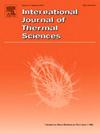在热流通量对流输运方程框架下穿孔涡发生器强化换热机理研究
IF 4.9
2区 工程技术
Q1 ENGINEERING, MECHANICAL
International Journal of Thermal Sciences
Pub Date : 2025-05-27
DOI:10.1016/j.ijthermalsci.2025.110024
引用次数: 0
摘要
本文在热流通量对流输运方程的框架下,研究了涡发生器穿孔技术对层流条件下局部和整体换热强化的影响。研究结果表明,射孔方式改变了沿x-y-z方向的热流通量传输强度,其中z方向的影响最为显著。在两个涡发生器之间的中间区域和近壁面区域,穿孔没有改变换热行为。在隔孔位置,由于流体速度的变化,换热速率先增强后抑制。然而,孔处流体速度的增加并不总是有利于热流通量的传递。在底部附近,射流通过提高流体速度来增强换热。相反,在射孔的上边缘附近,射流通过增加速度梯度来增强传热。此外,穿孔产生的射流降低了纵向涡的速度对热流传递的贡献,导致整体换热下降。本文章由计算机程序翻译,如有差异,请以英文原文为准。
Study on the mechanism of enhanced heat transfer through punched vortex generators in the frame of convective transport equation of heat flux
In this work, the impact of the perforation technique of vortex generators on both local and overall heat transfer enhancement under laminar flow was examined in the frame of convective transport equation of heat flux. The research findings revealed that the intensity of heat flux transmission along the x-y-z directions was altered by the perforation method, with the z-direction experiencing the most significant influence. In the intermediate region between the two vortex generators and the near wall region, perforation did not alter the heat transfer behavior. At the position across the hole, the heat transfer rate was enhanced first and then inhibited since the fluid velocity changed. However, the increment in fluid velocity at the hole does not always facilitate heat flux transmission. Near the bottom surface, the jet flow achieved heat transfer enhancement by increasing fluid velocity. Conversely, near the top edge of the perforation, the jet flow enhanced heat transfer by augmenting the velocity gradient. Moreover, the jet flow generated by the perforations reduced the contribution of the longitudinal vortices' velocity to heat flux transmission, resulting in a decline in overall heat transfer.
求助全文
通过发布文献求助,成功后即可免费获取论文全文。
去求助
来源期刊

International Journal of Thermal Sciences
工程技术-工程:机械
CiteScore
8.10
自引率
11.10%
发文量
531
审稿时长
55 days
期刊介绍:
The International Journal of Thermal Sciences is a journal devoted to the publication of fundamental studies on the physics of transfer processes in general, with an emphasis on thermal aspects and also applied research on various processes, energy systems and the environment. Articles are published in English and French, and are subject to peer review.
The fundamental subjects considered within the scope of the journal are:
* Heat and relevant mass transfer at all scales (nano, micro and macro) and in all types of material (heterogeneous, composites, biological,...) and fluid flow
* Forced, natural or mixed convection in reactive or non-reactive media
* Single or multi–phase fluid flow with or without phase change
* Near–and far–field radiative heat transfer
* Combined modes of heat transfer in complex systems (for example, plasmas, biological, geological,...)
* Multiscale modelling
The applied research topics include:
* Heat exchangers, heat pipes, cooling processes
* Transport phenomena taking place in industrial processes (chemical, food and agricultural, metallurgical, space and aeronautical, automobile industries)
* Nano–and micro–technology for energy, space, biosystems and devices
* Heat transport analysis in advanced systems
* Impact of energy–related processes on environment, and emerging energy systems
The study of thermophysical properties of materials and fluids, thermal measurement techniques, inverse methods, and the developments of experimental methods are within the scope of the International Journal of Thermal Sciences which also covers the modelling, and numerical methods applied to thermal transfer.
 求助内容:
求助内容: 应助结果提醒方式:
应助结果提醒方式:


